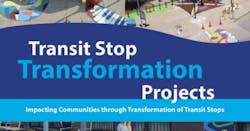Transit Stop Transformation Project: Improving Rider and Transit Experience, One Bus Stop at a Time
Waiting is a part of life, be it in the long lines at the bank or sitting on the metal benches at the bus stop. Waiting is usually an experience to be endured, rarely enjoyed, but a partnership developed in St. Louis, Mo., is changing the experience of neighborhood waiting areas, such as bus stops, using the concept of placemaking.
Citizens for Modern Transit (CMT) and St. Louis’ AARP launched the “Transit Stop Transformation Project” to activate bus stops in Missouri communities. One by one, bus stops in Missouri are being flipped to make waiting at a bus shelter a more enjoyable, inclusive and safe experience.
Through the program, communities are given the space to voice and address their bus stop concerns through placemaking strategy and development with a team of city planners, community leaders and designers. They come together to make a plan to address the needs and wants of the community and turn their standard bus shelters into a community place, fit for riders young and old.
A common concern that was brought up to St. Louis’ AARP Community Outreach Director Sheila Holm was the bus shelters were uncomfortable.
“[The bus stops] have seating that don't have backs or armrests to lean on,” Holm said. “They don't have a lot of shade, which doesn’t just affect older adults, but everybody.”
Taking on Maplewood
The Transit Stop Transformation Project was the product of a pilot program to demonstrate to the St. Louis region what could be made from a public transit space.
The bus stop that became the Transit Stop Transformation Project’s first initiative is a MetroLink and MetroBus service bus stop, located adjacent to the Citizens National Bank parklet in Maplewood, which is a diverse, inner-ring suburb of St. Louis with significant transit access. The goal of this program was to determine the impact of activating spaces in Maplewood around transit for current and future riders and residents.
Project work on this site began in fall 2019 and was completed and opened to the public in 2020.
Originally, the Maplewood shelter was an average black metal and clouded glass shelter surrounded by dull grass. Maplewood’s community saw a need for this space to become something more accessible and welcoming.
For a transit stop to qualify through the Transit Stop Transformation Project process, it must first have all funds secured. With the Maplewood MetroBus Stop project, most of the funding and resources came directly from the CMT and AARP, which began to organize and advertise fundraisers and events.
Getting the details of the project location prior to making plans was an element that Holm said was almost missed while planning everything out.
“Identifying who owns the land and property in which the bus stop is on or around the stop needed to happen much earlier than when we ended up doing on our first project, which in that case, ended up being a Citizens Bank. We had to convince the president of the bank that this was a good thing that we were trying to do, to develop the land and the stop and make it more of the fabric of the community,” Holm said.
Planting the seed
Holm says the idea of placemaking as a part of transit advocacy for the community she serves was a no brainer. Holm, who has a degree in agriculture, felt it was necessary “to plant the seed” into a program that works to improve a community overall. Better shelters, seating and design was only the starting point in the plans for the now five completed placemaking projects and one currently in the works.
“During the past several years, CMT and AARP in St. Louis have hosted a series of Pop-up Metro Markets to help area residents experience what it would be like if they could meet friends for coffee, grab groceries or take time out to relax, unwind or play in the vacant spaces currently surrounding MetroLink stations,” said Kimberly Cella, executive director of CMT. “The transformed Maplewood station brings these ideas to life as a permanent installment while creating a more inclusive and engaging transit stop.”
After listening to community members at a combination of in person and virtual meetings, a “modern front porch” setting was the final design direction that Maplewood wanted out of the space.
The design for the overall “Transit Stop Transformation Project” was led by BlackArc Design, with input from residents, including children.
The transformed, ADA accessible, Maplewood MetroBus Stop features vibrant colors and green spaces. New shelters, a glider and bench have been installed, as well as lighting and better sight lines to improve visibility, safety and security. There is also more waiting space, better access to the parklet and surrounding green spaces. In addition, an art installation featuring a Maplewood sign that graphically depicts landmarks in Maplewood was created by painter and mixed media artist Genevieve Esson who resides in Maplewood.
The design supported a playful and interactive safe space for adults to wait for their bus comfortably while their children were given a space to play hopscotch on the sidewalk and take in the colors of the now renovated bus shelter.
The stop itself has also been programmed into other healthy/ active living activities such as Ten Toe Express Walks, which gives the surrounding community the chance to join groups on walks that range from 0.3 to five miles, depending on the group and destination. Together these groups walk in a variety of places such as Forest Park or Carondelet Park, downtown St. Louis or Belleville, Ill. Programs like these use the bus stop as a landmark to reach while on the walks.
According to Cella, the project took between eight to 10 months of planning and construction. It was also a learning experience, as the teams tackled working in a new project size environment in the midst of the COVID-19 pandemic. One of the challenges to overcome included keeping the community actively engaged.
“When the pandemic hit, we had to get creative because that's when people started to shelter in place,” Cella noted. “We had to figure out a way to get to the community. We did geofencing, direct mail, questionnaires via social media. We were in as many different avenues as we could.”
Community space put to use
When asked about what makes her job rewarding, Holm noted that seeing riders use spaces AARP puts in place to benefit them makes her proud.
“One of the most rewarding things with these projects is seeing transit riders using what we've put in place, knowing they see the value of it and they're benefiting from it,” Holm stated. “They now see the value in the space. It makes them feel better and gives them a little sense of ownership of the space.”
Holm said that where it was common to have graffiti and trash at the old bus stop, now people are using trash cans and taking better care of the space.
As Mass Transit previously reported, Laura Miller, community development director for the city of Maplewood said, “This once unassuming corner in downtown Maplewood is no longer just a portal for transit riders passing through. It’s now a vibrant and engaging space that hopefully will encourage transit riders to explore our community and the wonderful things it has to offer.”
More to come
The success of the initial Transit Stop Transformation Project sparked interest in transforming other transit stops and stations in the St. Louis region. To date, Transit Stop Transformation Projects have been completed at the Emerson Park Transit Center in East St. Louis, Ill., the Belleville Transit Center in Belleville, Ill., and the North Hanley Transit Center in unincorporated St. Louis County.
In current works is the Fairview Heights transit center in Fairview Heights, Ill., and St. Clair County, Ill.
About the Author
Eman Abu-Khaled
Associate Editor
Eman Abu-Khaled is a former associate editor with Mass Transit magazine.

